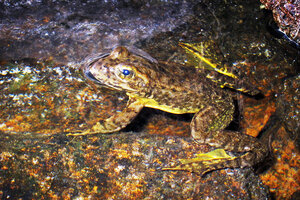What is killing Spain's amphibians?
Scientists have pinned down the identities of two closely-related viruses that are wiping out entire communities of toads and newts in Spain. Now they have to figure out how to slow them down.

This Aug. 10, 2013 file photo shows a rare mountain yellow-legged frog, which has experienced recovery in population numbers, in Kings Canyon National Park, in California's Sierra Nevada. The Southern California frog's cousins, including different species of toad, frog, and newt, aren't faring so well in northern Spain. In a new study, scientists have identified two related viruses that are threatening amphibian populations in the area.
Brian Melley/AP
It’s not easy being green.
It seems Spanish frogs and toads are not safe, even in protected national parks. And their most menacing predators aren't sizable animals but micro-organisms.
An international group of researchers that studied amphibians in a national park in northern Spain found that a pair of viruses is killing off entire communities of amphibious species. The team's findings, published this Thursday in the journal Current Biology, indicate that the spread of the related diseases isn't slowing down, either.
Two mass mortality events in 2005 sparked the investigation of the viruses at Picos de Europa National Park. Amparo Mora-Cabello de Alba, a biologist at the Picos de Europa, reached out to Jaime Bosch of the Museo Nacional de Ciencias Naturales in Madrid and together they decided to initiate monitoring of the threatened populations.
The scientists identified the viruses as part of the ranavirus group, but without a comprehension of how ranaviruses work, the group couldn't take immediate steps to slow down the spread of the diseases.
"We still haven't come a very long way in terms of understanding really how they're transmitted in the wild or the mechanism by which the pathology is caused," Stephen Price, lead author of the paper, told the Monitor.
So the research team began monitoring the species in 2007 and conducted yearly demographic surveys up until 2012. They found that the two closely related viruses were killing entire communities of three amphibian species: the common toad, the common midwife toad, and the alpine newt. The researchers determined that the viruses have infected six amphibian species in all, including frogs and salamanders, which isn't an abnormal occurrence for a ranavirus strain.
"It's not unusual for a pathogen to infect multiple hosts," says Dr. Price. "In fact, it's what we expect really. It's the norm."
What is unusual, though, is the fact that this pathogen is exploiting multiple, diverse hosts simultaneously.
Some scientists believe that the more diversity of species in a community and, consequently, the more hosts a pathogen infects, the less likely that pathogen will move onto others since chances are one host will be a dead end. Scientists refer to this hypothesis as the dilution effect: the pathogen becomes, in a sense, diluted in the large number of hosts.
Price and his colleagues haven't seen any signs of dilution with this group of ranaviruses, though.
"All the hosts seems suitable," says Price. "They are able to be infected and then amplify the infection by passing infectious particles back into the environment to infect other animals."
Scientists have noticed a similar situation among frog species in the UK, and despite the fact that these frogs have shown signs of adapting to the infection, their population numbers have not rebounded. So Price says it's quite possible that the amphibian species his team is studying could be driven to extinction.
In order to tackle this spread of disease, according to Price, scientists need to better understand how these viruses move globally as well as locally. The research team determined through genome sequencing that the viruses present in northern Spain are actually more closely related to viruses found in China than to each other, indicating a global pattern of spread that has yet to be mapped.
Knowledge of these viruses' paths could also have important applications for study of infectious disease in our own species, says Price, since pathogens which originated in wildlife, like avian flu, have been seen to jump to humans.
Price's team is working against the clock, though, as some of the threatened populations are now nearing 100 percent decline.
"I've never seen anything equal to it in terms of the severity," says Price.

